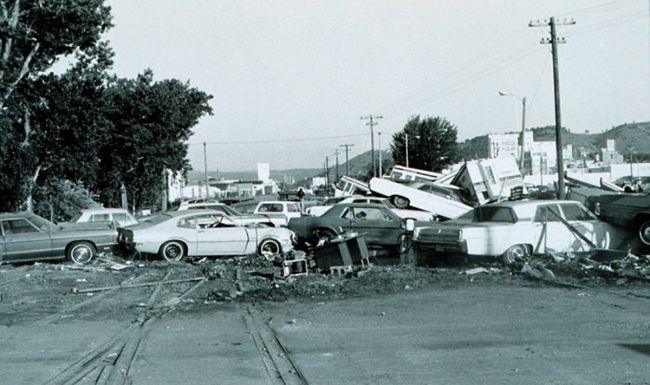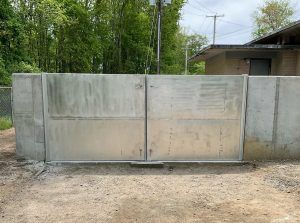Press Release
Media Contact
Email: media@floodpanel.com

The Rapid City Flash Flood
Image: Aftermath of the flash flood of June 9-10, 1972, Rapid City, South Dakota. Photo: NOAA
Rapid City, South Dakota was a medium-sized city of about 40,000 residents in 1972. The city had been founded a century earlier, after an expedition led by General George Custer had discovered gold in the surrounding Black Hills. A town sprang up in service to the hordes of fortune seekers who toiled for gold in the inhospitable terrain, and it was named after the Rapid Creek, which ran straight through the new town. Rapid City was touted as the ‘Gateway to the Black Hills’ by a group of promoters who were seeking opportunities other than digging for gold themselves. Almost exactly 100 years after the town was founded, the normally inconsequential creek that ran through Rapid City would all but destroy its namesake.
By early June of 1972, the ground in and around Rapid City had become fully saturated by heavy rainfall from the previous few days. Then, a series of conditions — each of which would have amounted to nothing on its own — began to collide. First, a low-altitude flow of moist air was forced up the steep, rocky slopes of the Black Hills, producing a condition called an ‘orographic lift’. An orographic lift happens when air is pushed from a low elevation to a high elevation, rapidly cooling the air as it gains altitude. This sudden cooling of the air creates clouds, quickly raises humidity to 100%, and produces rain. On this day of June 9, 1972, the entire set of variables was complicated by the lack of winds that are normally present at high altitudes over the Black Hills. So now, as this fateful day drew to a close, an orographic lift was setting up thunderstorms that would hover immobile over the area- and all that precipitation was about to fall on soggy, super-saturated soil.
When rain began to fall on the afternoon of June 9, it received little notice. The past few days had been rainy, so this was just a little more rain during an already rainy week. The fact that the rain began during the late afternoon was one more unlucky detail in a very catastrophic series of events. The downpour continued through the afternoon and evening, and into the night. But because night had fallen, people were unaware of just how much water was falling from the sky, and could not see how much runoff had been produced, and how quickly it was filling creeks, reservoirs, and any low-lying gulches. Most of the residents of Rapid City were sound asleep in their beds when disaster struck around midnight.
In a few short hours between the start of the storms at 3:30 and the explosive arrival of the flash flood at midnight, a lot had been happening. The main problem was the sheer volume of the precipitation: up to an incredible 12” of rain had been dumped on the sodden soil in and around Rapid City, an amount that even dry, absorbent soil would not be able to soak up. All that water immediately filled every creek and gully in the area, and began pulsing downstream, pushing before it a massive amount of debris. This debris piled up against any dam, bridge, or embankment that stood in its way, and in the case of the Canyon Lake Dam, created an unstable blockage that caused the lake to rise 11 feet in a few hours. Then it broke.
The massive wall of water that struck the sleeping town caused an unimaginable amount of damage. Trees, vehicles, boulders, bridges, and even sturdy buildings were swept away in minutes. There was no warning, and 238 people lost their lives as their homes were washed away like sand castles on the beach. Over 3000 others were injured, many grievously. The town of Rapid City was scraped clean, and it all happened in minutes. Five hours later, when the dawn revealed the horrors of the night, the creek had already returned to its normal level — this one of the incredible hallmarks of a flash flood. On June 10th, witnesses described scenes of incomprehensible damage. Over 1000 homes had been swept away, and almost 3000 others were damaged. 5000 cars had also been carried off, as well as all but a couple of the many bridges that served the area. The damage in terms of monetary loss was dire — estimated at around $165 million. This, combined with the considerable loss of human lives and livelihoods, means that the Rapid City Flash Flood still stands to this day as one of the worst flash floods in US history.


